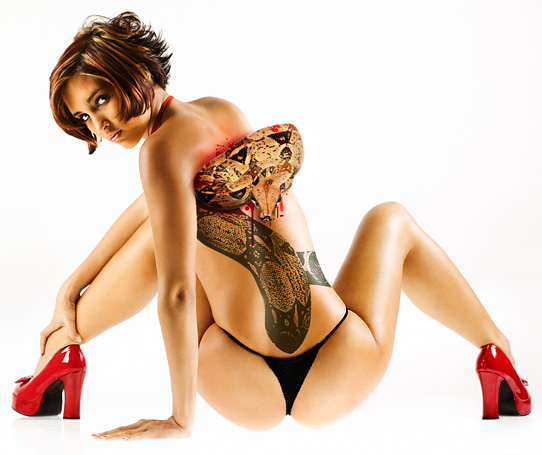

In the following tutorial you'll learn how to create a stylized snake
tattoo that jumps out of the subject's skin. All it takes is a little
bit of compositing and some airbrushing to detail this wild scene.

Start out by sourcing your stock photography. You'll need a compelling
subject with a fair amount of bare skin for tattooing. In this case,
we'll use a model with plenty of uncovered area. While searching for the
right photo of your desired tattoo, keep in mind the position and angle
it will lay on the skin. For this tutorial we'll use a straight-on shot
of a python.

Open your tattoo photo in Photoshop and use the Pen Tool (
video tutorial)
to outline the object from the background. Now right click on the
canvas and choose "Make Selection". Copy the selection (Ctrl + C), open
your model photo, and paste it into a new layer (Ctrl + Shift + N) on
top of your subject. Position the tattoo to your liking.

Some parts of the tattoo may extend off of the body or overlap onto
other body parts. We'll use the Pen Tool to create a tattooing area in
the same way we extracted the tattooing object, except this time trace
the contours of the skin, paying close attention to the parts of the
tattoo that fall off the subject or would be hidden underneath
overlapping limbs. However, you do not need to trim off parts of the
tattoo that will remain "real". With your path set, "Make Selection" and
then "Add layer mask".

Press "d" and then "x" to change the foreground color to white and
background color to black. Now copy your tattoo layer (Ctrl + J) and use
the new layer to apply a Stamp filter, found in the Sketch filters
menu. Play with the settings until you get your desired tattoo result.
For the example below, the light/dark balance was set to 25 and the
smoothness to 5. Another filter you may want to try is the Photocopy
filter. Note: it helps to be working with larger images to maintain
detail. Once your tattoo is ready, set the layer blending mode to
Multiply, and turn down the opacity to about 90%.

Here's where you decide what part of the tattoo will remain real. With
the unfiltered tattoo layer selected, make another selection to isolate a
section of the object and mask it ("Add layer mask") as you did before
with the pen tool. Make sure this "real" layer is now on top of the
filtered tattoo layer. To add some perspective, add shadows with a
medium black brush and low opacity onto a new layer in between your
tattoo layers. These soft diffused shadows will make the real portion of
the tattoo more three dimensional.
If your filtered tattoo appears a bit flat, add a new layer directly
above it and brush on some highlights with a low opacity white brush.
Follow the highlights that appear naturally on the skin. Keep this layer
subtle for a convincing light effect.

Just under your shadows layer, make a new layer for lightly brushing in a
red hue around the area of your "real" tattoo. This is to give the
effect of the skin becoming irritated by the tattoo's transformation. To
stretch the skin slightly, use the Smudge Tool with a low strength on
the model's layer. Make short outward strokes where the skin would
appear to be affected.

For some finishing touches, add some blood drips and splatters around
the ripped skin and on top of your tattoo. Making blood spots can done
with
custom brushes or using stock
photos of fake blood and red paint on a white background. Finally,
brush in some additional shadows, highlights, and adjust the color of
the tattoo to finish off your composition.

 View the final image
View the final image




























0 comments
Post a Comment